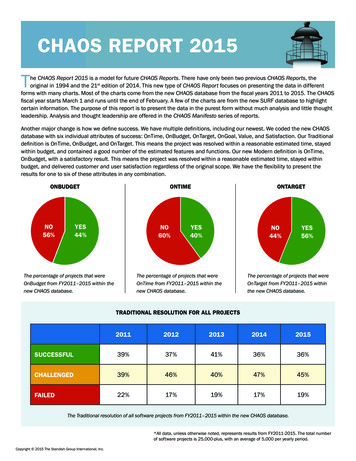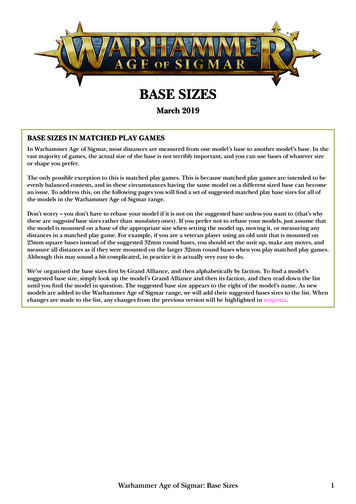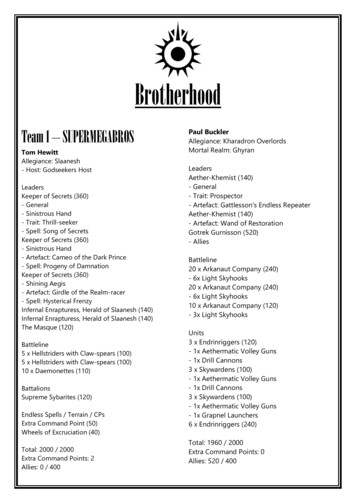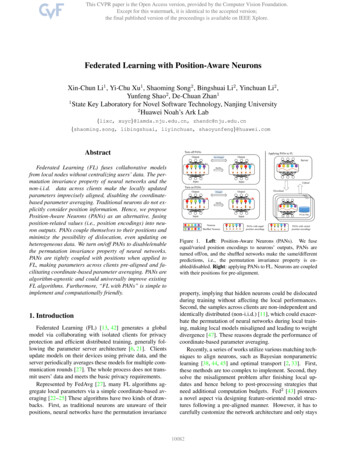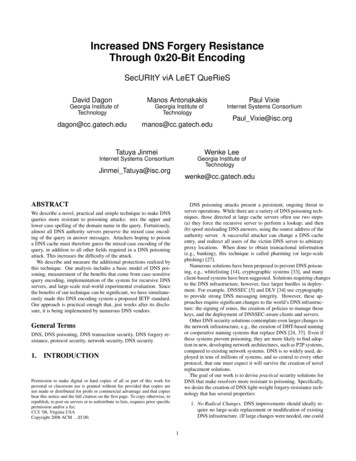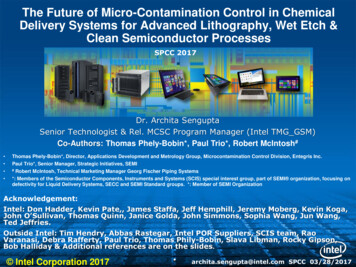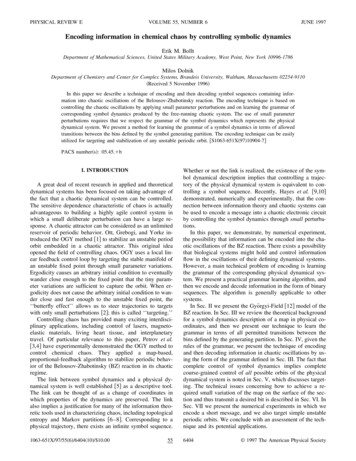
Transcription
PHYSICAL REVIEW EVOLUME 55, NUMBER 6JUNE 1997Encoding information in chemical chaos by controlling symbolic dynamicsErik M. BolltDepartment of Mathematical Sciences, United States Military Academy, West Point, New York 10996-1786Milos DolnikDepartment of Chemistry and Center for Complex Systems, Brandeis University, Waltham, Massachusetts 02254-9110 Received 5 November 1996!In this paper we describe a technique of encoding and then decoding symbol sequences containing information into chaotic oscillations of the Belousov-Zhabotinsky reaction. The encoding technique is based oncontrolling the chaotic oscillations by applying small parameter perturbations and on learning the grammar ofcorresponding symbol dynamics produced by the free-running chaotic system. The use of small parameterperturbations requires that we respect the grammar of the symbol dynamics which represents the physicaldynamical system. We present a method for learning the grammar of a symbol dynamics in terms of allowedtransitions between the bins defined by the symbol generating partition. The encoding technique can be easilyutilized for targeting and stabilization of any unstable periodic orbit. @S1063-651X 97!10904-7#PACS number s!: 05.45.1bI. INTRODUCTIONA great deal of recent research in applied and theoreticaldynamical systems has been focused on taking advantage ofthe fact that a chaotic dynamical system can be controlled.The sensitive dependence characteristic of chaos is actuallyadvantageous to building a highly agile control system inwhich a small deliberate perturbation can have a large response. A chaotic attractor can be considered as an unlimitedreservoir of periodic behavior. Ott, Grebogi, and Yorke introduced the OGY method @1# to stabilize an unstable periodorbit embedded in a chaotic attractor. This original ideaopened the field of controlling chaos. OGY uses a local linear feedback control loop by targeting the stable manifold ofan unstable fixed point through small parameter variations.Ergodicity causes an arbitrary initial condition to eventuallywander close enough to the fixed point that the tiny parameter variations are sufficient to capture the orbit. When ergodicity does not cause the arbitrary initial condition to wander close and fast enough to the unstable fixed point, the‘‘butterfly effect’’ allows us to steer trajectories to targetswith only small perturbations @2#; this is called ‘‘targeting.’’Controlling chaos has provided many exciting interdisciplinary applications, including control of lasers, magnetoelastic materials, living heart tissue, and interplanetarytravel. Of particular relevance to this paper, Petrov et al.@3,4# have experimentally demonstrated the OGY method tocontrol chemical chaos. They applied a map-based,proportional-feedback algorithm to stabilize periodic behavior of the Belousov-Zhabotinsky BZ! reaction in its chaoticregime.The link between symbol dynamics and a physical dynamical system is well established @5# as a descriptive tool.The link can be thought of as a change of coordinates inwhich properties of the dynamics are preserved. The linkalso implies a justification for many of the information theoretic tools used in characterizing chaos, including topologicalentropy and Markov partitions @6–8#. Corresponding to aphysical trajectory, there exists an infinite symbol sequence.1063-651X/97/55 6!/6404 10!/ 10.0055Whether or not the link is realized, the existence of the symbol dynamical description implies that controlling a trajectory of the physical dynamical system is equivalent to controlling a symbol sequence. Recently, Hayes et al. @9,10#demonstrated, numerically and experimentally, that the connection between information theory and chaotic systems canbe used to encode a message into a chaotic electronic circuitby controlling the symbol dynamics through small perturbations.In this paper, we demonstrate, by numerical experiment,the possibility that information can be encoded into the chaotic oscillations of the BZ reaction. There exists a possibilitythat biological systems might hold and control informationflow in the oscillations of their defining dynamical systems.However, a main technical problem of encoding is learningthe grammar of the corresponding physical dynamical system. We present a practical grammar learning algorithm, andthen we encode and decode information in the form of binarysequences. The algorithm is generally applicable to othersystems.In Sec. II we present the Györgyi-Field @12# model of theBZ reaction. In Sec. III we review the theoretical backgroundfor a symbol dynamics description of a map in physical coordinates, and then we present our technique to learn thegrammar in terms of all permitted transitions between thebins defined by the generating partition. In Sec. IV, given therules of the grammar, we present the technique of encodingand then decoding information in chaotic oscillations by using the form of the grammar defined in Sec. III. The fact thatcomplete control of symbol dynamics implies completecourse-grained control of all possible orbits of the physicaldynamical system is noted in Sec. V, which discusses targeting. The technical issues concerning how to achieve a required small variation of the map on the surface of the section and thus transmit a desired bit is described in Sec. VI. InSec. VII we present the numerical experiments in which weencode a short message, and we also target simple unstableperiodic orbits. We conclude with an assessment of the technique and its potential applications.6404 1997 The American Physical Society
55ENCODING INFORMATION IN CHEMICAL CHAOS BY . . .6405TABLE I. Parameters used in the 8.3331024000dm 6dm 6dm 3dm 7.5dm 3dm 3dm 3mol 22 s 21mol 22 s 21mol 21 s 21mol 22.5 s 21mol 21 s 21mol 21 s 21mol 21 s 21molmolmolmolmolmolmoldm 23dm 23dm 23dm 23dm 23dm 23dm 23FIG. 1. The one-dimensional map f l (x) derived from the threedimensional flow on the surface of the section corresponding to thenominal parameter value l 0 53.531024 s 21 . The discrete set consisting of many successive piercings of the section can be used toapproximate an arbitrary f l (x) for a point x not in the data set byusing a spline fit of the data to represent the map. The technique isequally accessible to experimental data using delay coordinates.II. THE MODELIn this paper we employ the most studied chaotic chemical system—the BZ reaction in a continuous-flow stirredtank reactor CSTR!. We use the Györgyi-Field @12# modelof the BZ reaction:dX52k 1 HXY 1k 2 AH 2 Y 22k 3 X 2dt10.5@ k 4 HA ! 1.5 C2Z ! X 0.52k 5 XZ # 1k o X o 2X ! , 1!dZ5k 4 HA ! 1.5 C2Z ! X 0.52k 5 XZ2 a k 6 VZ2 b k 7 BZdt1k o Z o 2Z ! , 2!dV52k 1 HXY 1k 2 AH 2 Y 1k 3 X 2 2 a k 6 VZ1k o V o 2V ! ,dt 3!@12# showed that the model displays chaos both at high andlow flow rates. In this paper we choose the low flow ratechaotic region to demonstrate the encoding procedure. Lowflow rate chaos is found for flow rates in the vicinity ofk o 53.531024 s 21 for parameters from Table I see the bifurcation diagram, Fig. 1 in Ref. @12#!. The same model@Eqs. 1!– 4!# and similar parametric conditions have beenpreviously used by Petrov et al. @3# to demonstrate the OGYmethod of chaos control.Equations 1!– 4! are stiff ODE’s and we use a modifiedsemi-implicit Runge-Kutta type fourth order method with automatic step length control for numerical integration.III. LEARNING THE GRAMMAROF THE SYMBOLIC DYNAMICSConsider the one-dimensional mapx n11 5 f l x n ! ,whereY5a k 6 ZVk 1 HX1k 2 AH 2 1k o 4!and the variable X denotes the concentration of HBrO 2 , andZ denotes the concentration of Ce 41 , V the concentration ofbromomalonic acid, and Y the concentration of Br 2 . Theconcentrations of these species in the inflow stream are denoted with subscript o. The parameter A represents the concentration of HBrO 3 , B is the concentration of malonic acid,and C is the total concentration of catalystC5 @ Ce41 # 1 @ Ce41 # . Kinetic parameters are denoted a andb @12#, and k 1 –k 6 are rate constants. In our study we allowsmall variations of the adjustable control parameter k o ,which denotes the flow rate.The values of the rate constants and fixed parameters usedin our simulations are given in Table I. Györgyi and Field 5!derived from the flow by the Poincaré section. We use aspecial case of Poincaré section—maxima of Z, which canbe easily determined in experiments. The adjustable parameter used for control, the flow rate k o , is written here as l.The map corresponding to the nominal parameter valuel 0 53.531024 s 21 is shown in Fig. 1. The link betweenchaotic evolution of phase space trajectories in Eq. 5! andorbits of the Bernoulli shift map on symbol space is wellestablished @5#.In the case of a one-hump map, where f l (x) has a singleinterior maximum or minimum, a two-character symbolspace S is sufficient to describe the dynamics of Eq. 5!.Given a decision point d, in the range of f l , a phase spacetrajectory, starting at the initial condition x 0 , corresponds toa symbol sequence as follows:
ERIK M. BOLLT AND MILOS DOLNIK6406s i5H0 if x i PL, where L5 @ x min ,d #1 if x i PR, where R5 d,x max# .55 6!A symbol sequence s i % i50 may be writtens 5 s 0 . s 1 s 2 s 3 , 7!which can be thought of as a point s PS, where S is thespace of all possible two-character, one-sided symbol sequences. Alternatively, the symbol point s , corresponding toan initial condition x 0 , can be thought of as the itinerary ofsuccessive left-right positions of the trajectory relative to thedecision point d.The Bernoulli shift map s:S S is defineds s ! 5s s 0 . s 1 s 2 s 3 ! 5 s 1 . s 2 s 3 s 4 . 8!As the decimal is shifted to the right one symbol, the leftmost symbol is forgotten, as a new symbol is brought intofocus. Bringing new symbols into ‘‘focus’’ is equivalent tocreating information, which we control by small parameterperturbations, d l. The expression ‘‘in focus’’ describes measurement accuracy, which is made rigorous by equipping thesymbol space S with the following norm:isi5(isi.2i 9!The shift map on the full symbol space, s:S S, definesthe fullshift. However, given an arbitrary map f l , notall symbol sequences correspond to the trajectory of aninitial condition x 0 . Restricting the shift map to a subsetof S consisting of all the itineraries that are generated byEq. 6! yields the subshift S ( f l ,d) ,S. The location of thedecision point dP @ x min ,x max# effects the set of admissiblesymbol sequences. For example, if d is chosen far to theright, symbol sequences tend to consist mostly of ‘‘0’s.’’ Wechoose d as the interior maximum point, which maximizesthe topological entropy of the resulting subshift @6#.Equipped with the topology induced by the symbol spacenorm, the dynamics of the subshift s u S( f l ,d) is semiconjugateto the dynamics of the map, f l u L in Eq. 5!, restricted to itsinvariant set L, @ x min ,x max# . Therefore, trajectories correspond to digital symbolic codes, which can be controlled byparameter perturbations. Since we wish to use only smallparameter perturbations, d l, the goal is to work within theexisting dynamics, rather than to create new dynamics withlarge or rude parameter variations. Therefore, we will workwithin the existing grammatical limitations of the subshiftcorresponding to f l 0 , for the chosen nominal parametervalue l 0 .The one-hump map f l is not uniformly hyperbolic; specifically, the zero slope at the critical point d, chosen as themaximum, corresponds to nonhyperbolicity for d and its orbit. The partition defines bins, corresponding to n-bit words.The bins are generated by the sequence of inverse images d, f 21 (d), f 22 (d), . . . , f 2(n21) (d) % , when these inversesexist @6#. When the map is not everywhere two onto one,some f 2i (d) will not exist, corresponding to illegal i-bitwords. A one-hump map is Kupka-Smale complete if it isonto the interval, and for such a map, all possible subse-FIG. 2. The norm i r(x) i as a function of x.quences correspond to orbits of the map @5#. We can see thatthe attractor displayed in Fig. 1 folds the interval@ x min ,x max# over itself less than exactly twice.Learning the grammar of the subshift is a nontrivial task,consisting of finding all the forbidden n-bit words, which aren-symbol sequence combinations. In general, the subshiftmay not be of finite type; the grammar may not consist of afinite list of n-bit forbidden words for any finite n. However,for our purposes, we do not need the full grammar; a finiteapproximation will suffice.With a computer, the goal is to learn an n-bit approximation to the grammar, for xP @ x min ,x max# on a grid. Thegrid points need to be fine enough to capture the naturalpartition generated by the bins, with mean size of order2 2n (x max2x min). With this in mind, the bit length n shouldbe chosen proportionally to the minimum experimental resolution d l min , approximated according to d x s maxxP[xmin ,x max] ] f l / ] l u (l 0 ,x) d l min , where d x s is the sizeof the smallest n-bit bin. In practice, the simple rule ofthumb is that a larger n-bit word size causes smaller corresponding bin sizes in the phase space, and this requires ahigher resolution both in measurements of the phase variablex and in parameter control. So, choosing n too large mayrequire perturbations or measurements beyond the accuracyof the experiment. The payoff is that smaller perturbation isrequired to encode the message for larger n. In the numericalexperiment, described in Sec. VII, we let n54 corresponding to a total of 2 n 516 possible words, and we useN51000 evenly spaced grid points.For each grid point y j , a symbolic itinerary is generatedaccording to Eq. 6!, creating an explicit correspondences 5r(x), where r: @ x min ,x max# S. Figure 2 displays thenorm of these itineraries as a function of x using Eq. 9!. Dueto the continual refolding of the interval into itself, the function is not monotonic. It is more useful to use the gray-codeordering according to the following formulas, which can befound in Cvitanovic et al. @7#. Given s i from Eq. 6!, defineS( Dkc k5andi51s i mod2 ! 10!
55ENCODING INFORMATION IN CHEMICAL CHAOS BY . . .FIG. 3. The monotonic nondecreasing g (x) function due to thegray-ordered symbolic codes. Note that since no symbolic code canhave a value g . g (x max), the gray-ordered value of the maximumof the map, a hole must be removed from the function. Likewiseremoving all preimages removes a Cantor set. g 50.c 1 c 2 5 ( c k 2 2k .k51 11!The order of g is the same as the ordering on the interval@ x min ,x max# , which causes the monotonic nondecreasing nature of the g (x) function, in Fig. 3. By the natural orderingof the gray-code, g (x)P @ g min , g max# , where g min5 g (x min)and g max5 g (x max). Thus the grammar must have limitationssince the function g (x) does not pass through the origin, asseen in Fig. 3. Therefore, any n-bit symbol sequence, corresponding to a gray-code g , such that g , g min , does not correspond to a trajectory of f l .We describe here a method of learning an n-bit approximation to the full grammar. The goal is to catalogue all ofthe n-bit words, and transitions between these words, whichare observed among the itineraries of the grid points. Thiscan be decided by a single pass, yes or no, flagging algorithmfor each n-bit word. The n-bit approximation to the grammarcan be visualized as a 2 n node directed graph see Fig. 4!.Each node represents one n-bit word, and each node canhave at most two arrows leading into it and two arrows leading out of it, corresponding to the choice of shifting in a ‘‘0’’or a ‘‘1.’’ The n-bit approximation to the grammar is equivalent to a 2 n 32 n transition matrix A, where an allowed transition from node j to node i is denoted by A i, j 51, and thedisallowed transition is denoted by A i, j 50. However, A isnecessarily sparse, and requires at most 2n computer checksagainst the grid to decide if the transition occurs, and at mosta 23n array for storage. The topological entropy, calculatedas the natural logarithm of the largest eigenvalue of the corresponding transition matrix @8#, is equal to h5ln2 for themaximal case representing an n-bit approximation of thefullshift grammar.For an arbitrary grammar, there will tend to be forbiddenn-bit words. Hence, the corresponding node is forbidden,which also erases the arrows both leading into and out of thenode. Thus, in terms of the transition matrix representation,6407FIG. 4. a! The fullshift grammar no words are forbidden! onthe two symbols ‘‘0’’ and ‘‘1’’; all permutations of two symbols,four at a time, and all possible Bernoulli-shifts, to 4-bit word accuracy. The only restriction on transitions is that one application ofthe Bernoulli shift map can only shift in a ‘‘0’’ or a ‘‘1’’ in a singleiteration. Thus, there are two arrows into and out of each node. b!A subshift which is of finite type and can be represented by theforbidden word ‘‘000’’ requires that all nodes representing wordswith three ‘‘0’s’’ in a row must be canceled. To maintain the closedand invariant property of the subshift, all arrows into and out ofthese nodes must also be eliminated. c! The resulting subshift hasa smaller directed graph. Some nodes, such as ‘‘0.100,’’ have noinformation carrying capacity. At this node, only a ‘‘1’’ can beshifted in; s(0.100)51.001 is the only possibility, becauses(0.100)51.000 is a forbidden word. Thus, node ‘‘0.100’’ is‘‘dead,’’ and so the bandwidth is not full.erasing the ith node requires that the ith row and column areeffectively erased from A. The topological entropy is lessthan the maximal value, ln2, corresponding to diminishedinformation carrying capacity. For example, Fig. 4 b! depictsa directed graph in which the 3-bit word ‘‘000,’’ three zerosin a row, is forbidden. Hence, the forbidden words include‘‘0000,’’ ‘‘0001,’’ and ‘‘1000.’’ These are all the 4-bitwords, which include ‘‘000.’’It follows that from the node ‘‘0100,’’ there is no choicein what node can follow. In 4-bit accuracy ,‘‘1001’’ mustfollow by requirement of the grammar. In terms of the shiftmaps 0.100 ! 51.001 , 12!written to 4-bit accuracy. At this node, only the single transition, shifting in a ‘‘1,’’ can occur, and hence there is noinformation carrying capacity at the ‘‘0100’’ node.In contrast, the node ‘‘0010’’ ends with ‘‘10’’ and doesnot have the possibility of a transition to the forbidden‘‘000’’ sequence in one application of the shift map. Hence,‘‘0010’’ is an information bearing node; there are two arrowsleading out of ‘‘0010,’’ one to ‘‘0100,’’ and one to ‘‘0101.’’In terms of the shift map,s 0.010 ! 50.100 or 0.101 13!is permitted by the grammar. The directed graph, or equivalently the transition matrix, represents the n-bit approximation of the grammar, which consists of all the allowed tran-
6408ERIK M. BOLLT AND MILOS DOLNIKTABLE II. The encoded 0001sitions between all the n-bit words. For a finite-typegrammar, there exists a finite n such that all forbidden wordsare considered.At this point, we have access to all possible transitions;the grammar is recorded as the transition matrix in compactform by the 23n array of yesses or nos. We also have anitinerary at each grid point y i . Thus, we know the grammar,and we know the code at each grid point. We still need tolearn how to encode a desired bit at each grid point.IV. ENCODING AND DECODING A MESSAGEA. EncodingThe directed graph represents the n-bit grammar of thegrid points in which a digital message can be encoded according to the following scheme. Suppose we wish to sendthe message from Table II. Note the distinction between then-bit register node! and the 7-bit ASCII codes. The message,in ASCII, is coded bit by bit into the dynamics as the transitions from information bearing nodes.Starting at an arbitrary initial condition x 0 , a simplesearch locates the nearest grid point y j . We associate to x 0the node r(y j ) @which we know as the course grained n-bititinerary, r: @ x min ,x max# S according to Eq. 6!# corresponding to y j , along with the node’s permitted transitions.Throughout the on-the-fly control experiment, the orbit ofx 0 will be stabilized to grid points, for insurance of knowledge of the outcomes.Examining the message in Table II. the first message bit isa ‘‘1.’’ If the node corresponding to y j is information bearing, then the ‘‘1’’ can be encoded. In this case, if the code ofthe natural image of y j contains in the least significant position a ‘‘1’’ bit, which is the desired bit for encoding themessage, then y j should be stabilized to its naturalimage—to the grid point y 8j closest to f l 0 (y j ). If the naturalimage of y j corresponds to encoding a ‘‘0’’ bit, then byconstruction there exists a nearby grid point y k such that the55grid point y 8k closest to f l 0 (y k ) corresponds to bearing theopposite of the natural bit—a ‘‘1’’ bit. Since y k can be foundnearby y j , a small parameter perturbation can be used tostabilize x 0 to the grid point y 8k nearest f l 0 (y k ).Alternatively, if the node corresponding to y j is not message bearing, y j must be stabilized to the grid point y 8j closest to the natural image, without bearing the desired bit.Nonbearing transitions through the directed graph, must bemade whenever a nonbearing node is visited. A nonbearingnode is defined as a node which has only one leaving arrow,corresponding to no choice, and therefore no informationcarrying capacity. The larger the number of nonbearingnodes, the slower the transmission rate, often called a smallbandwidth. The transmission rate, or information carryingcapacity of the directed graph, is measured by the topological entropy function.Each grid point y j has one fixed code, mapped to then-bit code r(y j ), and therefore there is a closest y i such thatr„f l 0 (y i ) has a ‘‘0’’ as the least significant digit, if shiftingin a ‘‘0’’ from node r(y j ) is permitted by the grammar.Likewise, there is a closest y k such that r„f l 0 (y k ) has a ‘‘1’’as the least significant digit, if permitted by the grammar.Thus, it is possible to preprocess the grid. Before any controlis done experimentally, we precalculate and record the closest point to grid point y j which shifts in a ‘‘0,’’ and theclosest point which shifts in a ‘‘1.’’ Thus the grammar ateach grid point can be prerecorded, and all the best targets ofall the grid points can be stored in a 23N array, for an Npoint grid. A huge advantage of prerecording is the speedand simplicity for ‘‘on-the-fly control’’ of an experimentalorbit of x 0 ; this only requires association of x t , at time t, toits nearest grid point y j , and then targeting y j ’s prerecordedtarget on the grid which transmits the desired bit, at a minimal energy cost. All pertinent data can be stored in a 33Narray, where the entries of the array can be arranged as follows. i! The first column, y j,1 , records the code and/or itineraryof the grid point, r(y j ). Note that forbidden n-bit words willnever appear on this list. ii! The second column, y j,2 , contains the grid number ofthe closest grid point y i8 to the natural image f l 0 (y j ), whichshifts in a zero. y 8i represents the target whose code r(y 8i )has a ‘‘0’’ as the least significant digit and it is the grid pointwhich shifts in the ‘‘0,’’ while requiring the smallest parameter perturbation. If shifting a ‘‘0’’ into the n-bit window isnot allowed by the grammar, we record a 21 in this position. It is necessary to transmit a nonmessage bearing bufferbit ‘‘1.’’ iii! The third column, y j,3 , contains the grid number ofy k8 , the closest grid point to the natural image f l 0 (y j ) whichshifts in a 1. If shifting a ‘‘1’’ into the n-bit window is notallowed, we record a 21 in this position. It is necessary totransmit a nonmessage bearing ‘‘0.’’Whenever both y j,2.0 and y j,3.0, indicating r(y j ) is amessage bearing node, the desired bit is transmitted, and onthe next iterate, the next bit of the message is considered. Ify j,2,0 or y j,3,0, then a nonmessage bearing bit a ‘‘bufferbit’’! is sent, and on the next iterate, the same message bit isagain attempted for transmission. It never happens that both
55ENCODING INFORMATION IN CHEMICAL CHAOS BY . . .y j,2,0 and y j,3,0; this indicates a forbidden n-bit word andas mentioned above such a word never appears on the list ofobserved orbits.B. DecodingThere are two alternative methods by which the controlledtime-series signal can be translated back into the originalmessage. Both techniques require translation of the timesseries into the sequence of n-bit nodes visited, that is, thepath through the directed graph. The first method requiresthat the receiver also has access to all the tools used by theencoder and/or controller. Given the full grid of points y j andtheir corresponding symbolic code r(y j ), the experimentaltime series can be translated to the sequence of n-bit nodesvisited, by associating the nearest grid points y j to the timeseries x t at each time t.The second method is related to the first in that we interpret transitions through the directed graph, except we do notrequire that the decoder has access to the original N pointgrid approximating the function r(x). The alternative andmore realistic idea is to read the itinerary directly from thecontrolled time series x t , by comparison of x t to the decisionpoint d at each time t, according to Eq. 6!. This informationis easily translated into the sequence of n-bit nodes visitedby considering a sliding n-bit block through the long itinerary sequence corresponding to x t .At this point, interpretation of the path through the directed graph into the digital message is the same for bothtechniques above. We must strip off the ‘‘buffer bits’’ whichwere added during encryption. Given knowledge of permissible transitions through the 2 n node directed graph, the sequence of nodes actually visited can be translated into theencoded message by reading the transitions only from theinformation bearing nodes. Just as was the case during encryption, the decoder reads the choice of shifting in a ‘‘0’’ ora ‘‘1’’ in terms of the actual transitions away frominformation-bearing nodes. However, the transitions awayfrom nonbearing nodes must be ignored, effectively strippingthe buffer bits that the encoder was required to send.Encoding a message requires the insertion of a buffer‘‘1’’ every time after two ‘‘0’s’’ have occurred. So to sendthe message ‘‘0000,’’ it is necessary to send the bits‘‘001001’’ to avoid the illegal three bit word ‘‘000’’ everoccurring in the 4-bit sliding block window. Encryption withbuffer bits, for an arbitrary n-bit grammar, occurs automatically when encoding by use of the directed graph method.The interpretation of the path through the directed graph decryption described above automatically strips the buffer bits.The method has the advantage that interpreting the grammaris all done automatically on the computer. This saves a largepart of the difficulty found in @9# of interpreting the grammarof the dynamical system; it is never necessary to try to‘‘manually’’ deduce any fundamental word restrictions suchas forbidding ‘‘000’’! and then to manually insert and thenstrip buffer bits, on a case by case basis, to prevent the forbidden words. The list of n-bit nodes and their allowed transitions is sufficient for encoding and decoding.C. NoiseThe encoding method can be made robust to noise andmodeling errors. Errors to the time-series x t , due to noise,6409can cause misidentification of location of x t relative to dwhen u x t 2d u is small @11#. A ‘‘0’’ when x t ,d may be interpreted as ‘‘1’’ when a small error causes the readingx t .d. If noise volume d x n is possible, then it is necessary toavoid targeting the interval I5 @ d2 d x n ,d1 d x n # and all preiterates of I, I, f 21 (I), f 22 (I), . . . % , which defines the holesof a Cantor set that are subtracted from the attractor L. Notethat as the noise gap is increased, the measure of the Cantorset decreases. Also, the restrictions on the grammar increase,and therefore the bandwidth decreases @14#. We did not formally remove such a Cantor set in this work.We use a pragmatic technique to prevent errors in controlfrom effecting the message. Interpreting the threedimensional flow as a one-dimensional map causes a smallerror in predicted control response, which we discuss in thenext section. If a small error causes x t , which was targeted aty i 8 , whose code is r(y i 8 ), to land at y, and r(y)Þr(y i8 ), thenthere is a coding error. If y i8 is near the boundary ] S i8 of theconnected set S 8i 5 z:r(z)5r(y 8i ) % , the set of all points withthe same code as the desired target, then even a small targeting error will be prone to coding errors. The simple fix to thisproblem is to avoid targeting points near the boundaries ofcode regions. Simply put, we define a buffering size ofm-grid points, and we avoid targeting a point which is lessthan m points from the boundary of a code region. That is,we add the following caveat when forming the prerecorded33N list of targets: y j,2 lists the grid number of the optimalenergy target, from y j , to transmit a ‘‘0.’’ If y j,2 is more thanm grid points from the boundary of its code region, then it isalready noise error resistant. But if y j,2 is less than m gridpoints from the boundary, then we store instead the noiseresistant and nearby point which is exactly m grid pointsfrom the boundary, in the array location y j,2 . We similarlyalter the third column of the array, y j,3 , of optimal energytargets which shift in a ‘
Department of Chemistry and Center for Complex Systems, Brandeis University, Waltham, Massachusetts 02254-9110 Received 5 November 1996! In this paper we describe a technique of encoding and then decoding symbol sequences containing infor-mation into chaotic oscillations of the Belousov-Zhabotinsky reaction. The encoding technique is based on
